To push the theoretical promise of stem cell research into the world of viable I treatments, scientists have successfully fashioned adult stem cells into the kind of eye cells that might someday replace those that fall victim to the onset of age-related macular degeneration, or AMD.
No Embryonic Stem Cell Use
The work did not involve embryonic stem cells, which have been the subject of much debate in recent years, but rather involved socalled "human-induced pluripotent stem cells." The aim, according to the researchers, was to develop a therapeutic response to the death, caused by AMD, of retinal pigment epithelium, a cell layer that is critical to the health of the retina's vision cells.
The researchers, from the Georgetown University Medical Center in Washington, DC, stress that this was a preliminary move toward that goal, achieved solely in a laboratory setting. They say that numerous complex obstacles must be tackled before such newly created cells could be transplanted into diseased eyes.
Generating Functional Retinal Cells
"But we have shown that we are able to generate retinal cells from cells originally taken from a small amount of biopsied skin, that are then induced to become stem cells," noted Nady Golestaneh, PhD, an assistant professor in the department of biochemistry and molecular and cellular biology at Georgetown, and a coauthor of a report on the research, published in the journal Stem Cells. The study was funded by the US National Institutes of Health.
"The retinal cells we have generated are really functional," Dr. Golestaneh explained. "That means they mimic the function of native retinal cells that play a key role in the eye for light absorption, nutrition and receptor function."
That's important because, if these cells die, they can induce disease in the eye, including age-related macular degeneration," she said. "Until now, there has not been any medication that can stop this disease. So basically these people lose their central vision, which we need for daily tasks like reading, driving or anything that you need to do to be independent."
In the United States, AMD is a leading cause of vision loss among people 60 and older.
Demetrios Vavvas, MD, PhD, an attending physician in the retina service of the Massachusetts Eye and Ear Infirmary and an assistant professor of ophthalmology at Harvard Medical School, described the research results as a "major step forward."
“But this is still very early work," Dr. Vavvas noted. "This has been achieved only in-vitro. It is in-lab work with cell cultures. So it's still a question how this will work in person because there are still hurdles that need to be overcome," he added.
"For example, all of this work so far needs viruses to function as cell carriers, and this creates problems," he explained. "So, people are now trying to see if they can replicate this kind of lab work without the use of viruses. That will have to happen before we can go to human trials. And we're not there yet," Dr. Vavvas said.
"With the current know-how and technology, we're probably talking a minimum of three to five years before we can even go to clinical trials," he pointed out.
Research Details
The researchers used a line of adult stem cells that had been a relied-upon source for lab research. They said that the differentiation process that prodded the stem cell stock to develop into retinal cells equivalent to those damaged by AMD took many weeks of high-tech culturing, but ultimately the stem cell-generated retinal cells exhibited the same functional capacity and gene expression as naturally occurring retinal cells, the researchers reported.
However, they cautioned that the cell line they generated also appeared to display DNA chromosomal damage, aspects of over-expression that prompted growth inhibition and some structural abnormalities.
Though the generated cells were deemed "viable," the researchers said that more work would be needed to render them "safe" for treatment purposes.
"But when we talk about the potential use of stem cells, we shouldn't only think about transplantation," Dr. Golestaneh said. "They could also be used as an in-vitro model to study the disease itself in the lab—their function, their impairment, gene mutations. That would help to generate targeted drugs to cure the disease."
That makes the cells "very valuable not only for transplantation but also to study the mechanism of the disease and advance drug development," Dr. Golestaneh said.
New Treatment for Cataracts
A new cataract treatment uses an infrared laser to "bleach" the age-induced yellowing of the lens. The procedure, now being tested, takes about a half-hour and could eventually be done in mobile clinics.
Cataracts are now treated with invasive lens-replacement surgery by a team of eye surgeons. Cataracts are the number-one cause of blindness in the world.
